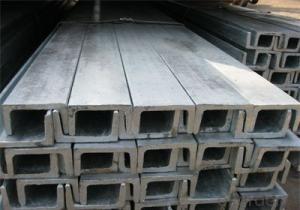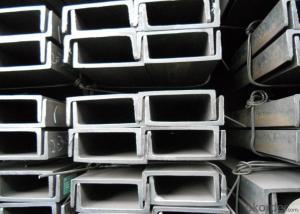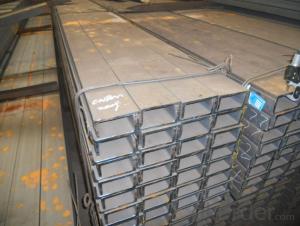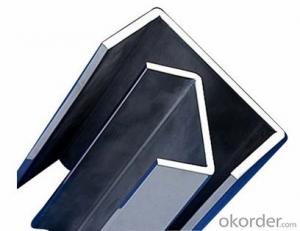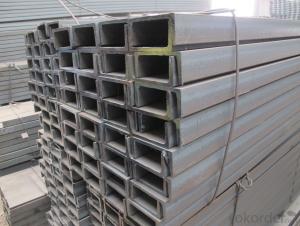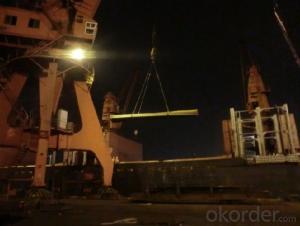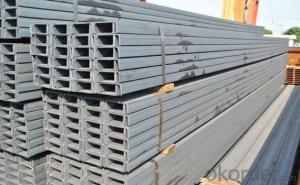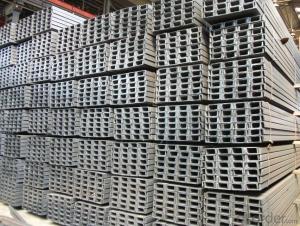Good Quality Steel U Channel For Special Normal Container Used
- Loading Port:
- Tianjin
- Payment Terms:
- TT OR LC
- Min Order Qty:
- 25 m.t.
- Supply Capability:
- 5000 m.t./month
OKorder Service Pledge
OKorder Financial Service
You Might Also Like
Description
In the production of steel products, steel is molded and reshaped with different machinery at different temperatures. One process is steel rolling, which involves metal stock passing through a pair of rolls. Rolling produces flat steel sheets of a specific thickness, and the process is classified according to the temperature at which the metal is rolled. If the temperature of the metal is above its recrystallization temperature, or the temperature at which the grain structure of the metal can be altered, then the process is termed as hot rolling. If the temperature of the metal is below its recrystallization temperature, the process is termed as cold rolling.
Like cold rolling, cold drawing is performed at room temperature, but instead of producing a flat object like a coke can, cold drawing makes steel into the form of a wire like the spokes of a wheel or a paper clip. To start the process, Steel is usual hammered and rolled so that it can be fit through a die; a tool that turns the steel mass into a wire. The room temperature steel is pulled through the die which reshapes it into a thinner shape while maintaining the same volume. It is similar to the idea of syrup flowing out of a bottle through a tube in that it changes shape but not volume, but instead of squeezing the metal, it is pulled out. In order to get the wire down to the right diameter, it usually requires more than one pass through different dies.
Chemical Compostion
Grade | Element(%) | |||
C | Mn | P | S | |
SS330 | -- | -- | ≦0.050 | ≦0.050 |
SS400 | ||||
SS490 | ||||
SS540 | ≦0.30 | ≦1.60 | ≦0.040 | ≦0.040 |
Usage/Applications
Channel Steel is usually used for building structure, vehicle manufacturing and other industrial structure and often used with i beam.
In details, the channel steel belongs to carbon structural steel which is applied to in the field of construction and machinery. The channel steel is usually used for arch-itechtural structure, and they could be welded in order to support or hang a vari-ety of facilities. They are also usually used in combination with I beam. Generally,the channel steel must possess perfect welding property, riveting property and mechanical property and so on.
FAQ:
Q1: How soon can we receive the product after purchase?
A1: Within three days of placing an order, we will begin production. The specific shipping date is dependent upon international and government factors, but is typically 7 to 10 workdays.
Q2: What makes stainless steel stainless?
A2: Stainless steel must contain at least 10.5 % chromium. It is this element that reacts with the oxygen in the air to form a complex chrome-oxide surface layer that is invisible but strong enough to prevent further oxygen from "staining" (rusting) the surface. Higher levels of chromium and the addition of other alloying elements such as nickel and molybdenum enhance this surface layer and improve the corrosion resistance of the stainless material.
Q3: Can stainless steel rust?
A3: Stainless does not "rust" as you think of regular steel rusting with a red oxide on the surface that flakes off. If you see red rust it is probably due to some iron particles that have contaminated the surface of the stainless steel and it is these iron particles that are rusting. Look at the source of the rusting and see if you can remove it from the surface.
Q4: Can stainless steel rust?
A4: Stainless does not "rust" as you think of regular steel rusting with a red oxide on the surface that flakes off. If you see red rust it is probably due to some iron particles that have contaminated the surface of the stainless steel and it is these iron particles that are rusting. Look at the source of the rusting and see if you can remove it from the surface.
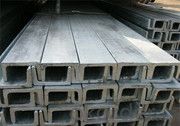
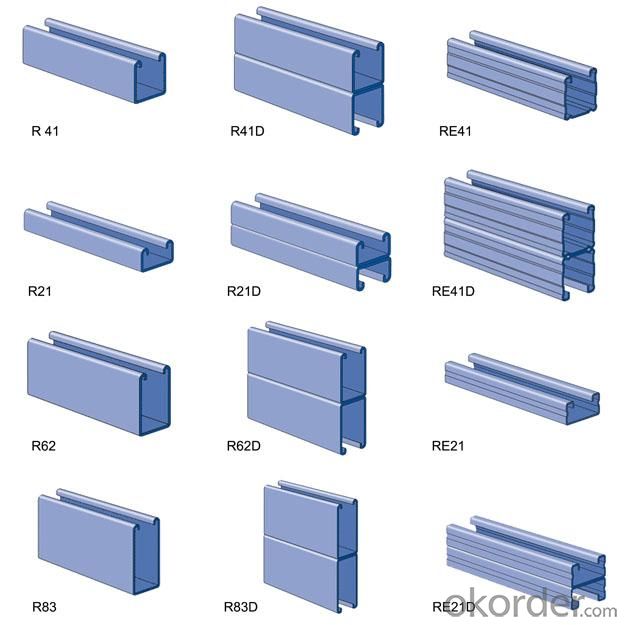
- Q: Can steel channels be customized to specific lengths?
- Indeed, it is possible to customize steel channels to meet specific length requirements. Although steel channels are typically found in standard sizes, they can be altered or trimmed to match the desired length. This customization process entails cutting the steel channel to the desired length and may also involve implementing welding or other techniques to uphold its structural integrity. The ability to customize steel channels offers enhanced flexibility in a variety of construction and engineering applications.
- Q: What is the maximum length of steel channels available?
- The maximum length of steel channels available can vary depending on the manufacturer, but it is typically around 30 feet.
- Q: How do you calculate the weight of 100 channel steel?
- If it is GB, the channel can be checked by the hardware manual sheet, and the weight is multiplied by the length of each meter, that is, its weight.
- Q: 18# channel perimeter
- Channel 18#A 180*68*7.0 theory weight 20.174, section area 25.69, channel 18#B 180*70*9.0 theory weight 23, section area 29.29, average leg thickness 10.5, inner arc radius 10.5, leg end arc radius 5.25
- Q: What are the tolerances for steel channels?
- The tolerances of steel channels can differ based on several factors, including the type of channel, the manufacturing process, and the intended use. Generally, steel channels are specified with tolerances regarding their dimensions, such as width, depth, and length. For instance, the tolerances for the width and depth of steel channels can vary from +/- 0.005 inches to +/- 0.030 inches, depending on the channel's size and grade. Similarly, the length tolerances can range from +/- 1/8 inch to +/- 1/4 inch, based on specific requirements. It's important to note that these tolerances are typically determined by industry standards or customer specifications. Their purpose is to ensure that steel channels meet the desired dimensional requirements for a particular application. These tolerances allow for minor variations in channel dimensions without compromising their functionality or structural integrity. In addition to dimensional tolerances, other tolerances may be specified for factors like straightness, twist, and surface finish. These tolerances play a vital role in ensuring that steel channels meet the necessary quality standards and are suitable for various applications, such as construction, manufacturing, and structural engineering. Ultimately, it's essential to refer to the relevant standards or specifications for the specific type of steel channel in use to ascertain the precise tolerances that must be adhered to.
- Q: Are steel channels suitable for use in the construction of scaffolding systems?
- Yes, steel channels are suitable for use in the construction of scaffolding systems. Steel channels are known for their strength and durability, making them ideal for supporting heavy loads in scaffolding structures. They are often used as horizontal or vertical beams to provide stability and support to the scaffolding system. Steel channels also have high resistance to corrosion, which is essential for outdoor construction sites where the scaffolding may be exposed to various weather conditions. Additionally, steel channels can be easily fabricated and assembled, allowing for flexibility and customization in designing scaffolding systems to meet specific construction requirements. Overall, steel channels offer the necessary strength, durability, and versatility required for scaffolding systems, making them a suitable choice for construction projects.
- Q: Can steel channels be used in seismic applications?
- Yes, steel channels can be used in seismic applications. Steel channels are often used to provide structural support and stability in buildings and structures during seismic events. They are designed to withstand the forces generated by earthquakes and can help to distribute and dissipate the energy that is produced. Additionally, steel channels offer high strength and ductility, making them suitable for seismic applications where flexibility and resilience are required.
- Q: Can steel channels be used in the chemical manufacturing industry?
- Steel channels are indeed applicable in the chemical manufacturing industry. These channels offer structural support and find use in diverse applications, including the construction of chemical storage tanks, platforms, walkways, and support structures for equipment and piping systems. Steel is renowned for its durability, strength, and resistance to corrosion, making it well-suited for chemical environments that often entail exposure to corrosive substances and high temperatures. Moreover, steel channels can be tailored and manufactured to fulfill specific design needs, providing flexibility during construction and installation. All in all, steel channels emerge as a dependable and adaptable option for the chemical manufacturing industry.
- Q: What are the different methods of strengthening steel channels?
- There are several methods used to strengthen steel channels, including heat treatment, cold working, and alloying. Heat treatment involves subjecting the steel to high temperatures and then cooling it rapidly, which alters its microstructure and increases its strength. Cold working, on the other hand, involves deforming the steel at room temperature through processes like rolling or drawing, which also enhances its strength. Alloying refers to adding other elements to the steel, such as carbon or chromium, to improve its properties and make it stronger.
- Q: What are the different load-bearing tests conducted on steel channels?
- Some of the different load-bearing tests conducted on steel channels include the tensile test, bending test, compression test, and shear test. These tests are conducted to evaluate the strength and durability of steel channels under different loading conditions and to ensure they meet the required specifications and standards.
Send your message to us
Good Quality Steel U Channel For Special Normal Container Used
- Loading Port:
- Tianjin
- Payment Terms:
- TT OR LC
- Min Order Qty:
- 25 m.t.
- Supply Capability:
- 5000 m.t./month
OKorder Service Pledge
OKorder Financial Service
Similar products
Hot products
Hot Searches
Related keywords
